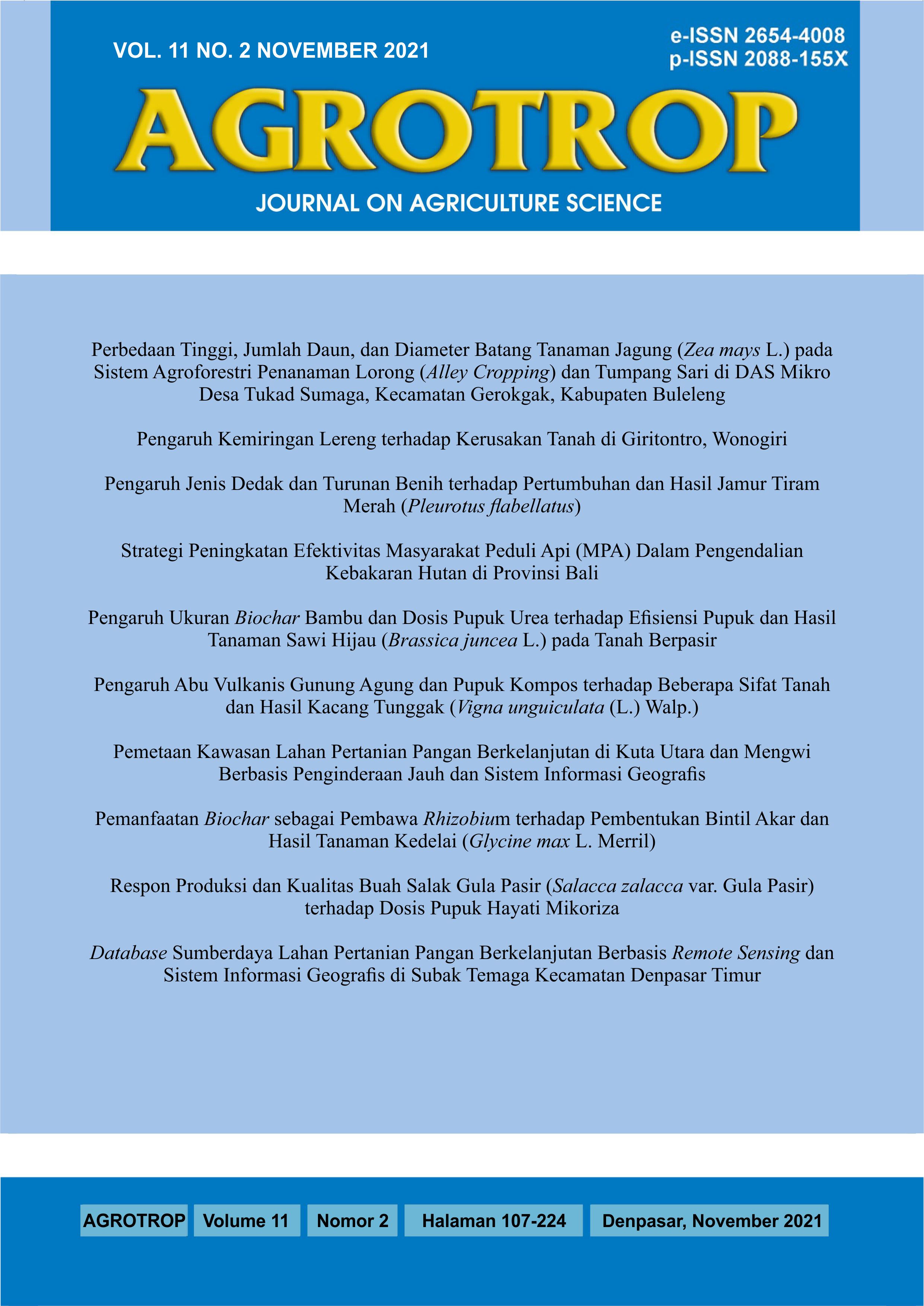Pemanfaatan Biochar sebagai Pembawa Rhizobium terhadap Pembentukan Bintil Akar dan Hasil Tanaman Kedelai (Glycine max L. Merril)
Abstract
The Utilization of Biochar as a Carrier of Rhizobium for the formation of root nodules and Yield of Soybean (Glycine max L. Merril). This study aims to determine the effect of the type of raw materials and particle size of biochar as a Rhizobium carrier on the formation of nodules in soybean plants. This research was conducted from September to November 2020 at the Experimental Station and Laboratory of Soil and Environmental Sciences, Faculty of Agriculture, Udayana University. The research design used was a randomized block design with nested patterns with 2 factorials and 3 replications. The treatment factors consisted of B1 = bamboo biochar, B2 = albasia wood biochar, B3 = corncob biochar, B4 = young coconut skin biochar, P1 = (0,15-0,50 mm), P2 = (>0,50-1,68 mm), P3 = (>1,68-3,36 mm). The parameters observed included effective nodule, nodule size, total bacterial population, ammonium, nitrate, and plant yield. The result of the analysis showed that the type of biochar raw materials had a very significant effect on the parameters of effective nodules, nodules size, total bacterial population and plant yield, but had no significant effect on soil chemical parameters. The treatment of biochar particle size had a very significant effect on the parameters of effective nodules, total bacterial population, and plant yield, and had a significant effect on the size of nodules, but had no significant effect on soil chemical parameters. The conclusion of this study is that the type of raw material for albasia wood biochar is effective as a Rhizobium carrier, which is indicated by the high number of effective nodules, nodules size and total bacterial population of 0,15-1,68 mm particles.
Downloads
References
Atmaja, I. W. D. (2016). Modul Praktikum Bioteknologi Tanah. Universitas Udayana. 47 hal.
Bachtiar, T., Anas, I., Sutandi, A., & Ishak. (2019). Perbaikan Kualitas Bahan Pembawa Rhizobium dan Fungi Pelarut Fosfat melalui Sterilisasi Sinar Gamma Co-60 dan Pengaruhnya terhadap Pertumbuhan dan Produksi Kedelai (Glycine max L.). Jurnal Iptek Nuklir Ganendra, 22(1):11-23.
Balai Penelitian Tanah. (2005). Petunjuk Teknis analisis Kimia Tanah, Tanaman, Air, dan Pupuk. Badan Penelitian dan Pengembangan Pertanian. Departemen Pertanian, Bogor.
Battaglia M., Rípodas, C., Clúa, J., Baudin, M., Aguilar, O. M., Niebel, A., Zanetti, M. E., & Blanco, F. A. (2014). A Nuclear Factor Y Interacting Protein of the GRAS Family Is Required for Nodule Organogenesis, Infection Thread Progression, and Lateral Root Growth. Plant Physiology, 164: 1430-1442.
Chen, J., Li, S., Liang, C., Xu, Q., Li, Y., Qin, H., & Fuhrmann, J. J. (2017). Response of Microbial Community Structure and Function to Short-Term Biochar Amendment in an Intensively Managed Bamboo (Phyllostachys praecox) Plantation Soil: Effect of Particle Size and Addition Rate. Science of the Total Environment, 574: 24-33.
Glodowska, M. (2014). Biochar as A Potential Inoculant Carrier for Plant Beneficial Bacteria. Thesis. Macdonald Campus of McGill University.
Kementerian Pertanian Republik Indonesia. (2016). Biochar. [internet] http://repository.pertanian.go.id/bitstream/handle/123456789/6252/Leaflet%20Biochar%203.pdf?sequence=1&isAllowed=y (diakses pada tanggal 09 Desember 2019).
Maharani, P. S. (2008). Nodulasi dan Efektivitas Rhizobium Endogen Tanah Entisol dan Vertisol pada Tanaman Kedelai (Glycine max (L.) Merril). Skripsi. Universitas Islam Negeri Malang.
Nurida, N. L. (2014). Potensi Pemanfaatan Biochar untuk Rehabilitasi Lahan Kering di Indonesia. Jurnal Sumberdaya Lahan Edisi Khusus : 57-68.
Purwani, J & Sucahyono, D. (2020). Viabilitas Rhizobium dalam Formula Bahan Pembawa dan Cara Inokulasi Dalam Teknik Produksi Pupuk Hayati. Jurnal Agrosain dan Teknologi, 5(2): 99-107.
Putri, V. I., Mukhlis, & Hidayat, B. (2017). Pemberian Beberapa Jenis Biochar Untuk Memperbaiki Sifat Kimia Tanah Ultisol dan Pertumbuhan Tanaman Jagung. Jurnal Agroekoteknologi FP USU, 5(4): 824- 828.
Quilliam, R. S., Glanville, H. C., Wade, S. C., & Jones, D. L. (2013). Life in the ‘charosphere’ – does biochar in agricultural soil provide a significant habitat for microorganisms? Soil Biol. Biochemistry, 65: 287–293.
Rostaliana, P., Prawito, P., & Turmudi, E. (2012). Pemanfaatan Biochar untuk perbaikan kualitas tanah dengan indikator tanaman jagung hibrida dan padi gogo pada sistem lahan tebang dan bakar. Naturalis-Jurnal penelitian Sumberdaya Alam dan Lingkungan, 1(3).
Sa’adah, N., & Islami, T.. (2019). Pengaruh Pemberian Macam Biochar dan Pupuk N terhadap Pertumbuhan dan Hasil Tanaman Kedelai (Glycine max L.). Jurnal Produksi Tanaman, 7(11) : 2077-2083.
Sari, R. R. F., Aini, N., & Setyobudi, L. (2015). Pengaruh Penggunaan Rhizobium dan Penambahan Mulsa Organik Jerami Padi pada Tanaman Kedelai Hitam (Glycine max (L.) Merril.) Varietas Detam 1. Jurnal Produksi Tanaman, 3(8):689-696.
Sarwono, R. (2016). Biochar Sebagai Penyimpan Karbon, Perbaikan Sifat Tanah, dan Mencegah Pemanasan Global: Tinjauan. J. Kim. Terap. Indones., 18(1): 79-90.
Satriawan, B. D., & Handayanto, E. (2015). Effects of Biochar and Crop Residues Application on Chemical Properties of A Degraded Soil of South Malang, and P Uptake by Maize. Journal of Degraded Andmining Lands, 2(2): 271 – 281.
Tarigan, A. A. L. B., Riniarti, M., Prasetia, H., Hidayat, W., Niswati, A., Banuwa, I. S., & Hasanudin, U. (2021). Pengaruh Biochar pada Simbiosis Rhizobium dan Akar Sengon Laut (Paraserianthes falcataria) dalam Media Tanam. Journal of People, forest and Enviromental, 1(1)
Vanek, S. J., Thies, J., Wang, B., Hanley, K., & Lehmann, J. (2016). Pore- Size and Water Activity Effects on Survival of Rhizobium Tropici in Biochar Inoculant Carriers. J Microb Biochem Technol, 8: 296-306.











